Camper FAQs is reader-supported. Buying through links on our site may earn us an affiliate commission. As an Amazon Associate I earn from qualifying purchases.
RVing during winter can be as much fun as any other time of the year. Have you ever seen Yellowstone National Park in the winter? There’s nothing like it!
That said, the cold weather can be tough on your vehicle (and you), so it’s crucial to plan well.
The real challenge in keeping a camper warm in winter is to ensure that it’s adequately insulated.
Some campers are equipped with optional winter packages, but if yours isn’t, don’t worry. You can get your RV in winter camping shape in just a few steps.
Insulating a Camper for Winter Living
Whether you have a new or old RV, here are a few tips on how to insulate a camper for winter use and make the most of your recreational investment.
Related: How to Winterize a Camper to Live In (Step-by-Step)
1. Install Skirting
Skirting is one of the most effective ways to limit airflow beneath your camper.
Options range from custom vinyl skirting made specifically for your model (which can be expensive) to canvas skirts to air skirts.
You can even install DIY RV skirting using foam insulation boards, vinyl tarp, insulated siding, or plywood.

Remember that skirting works best if you stay in a campground for at least a few days or more. Spending a few hours skirting your rig might not be practical when you’re only camping for a weekend.

Adco Polar White RV Wheel Skirt
Price:Clicking this link to make a purchase may earn us a commission at no additional cost to you.
2. Insulating the RV Underbelly
One issue with RV skirting is the need to put it up and take it back down every time you have to move your camper trailer, which brings us to a more permanent solution – insulating the RV underbelly.
When preparing your travel trailer or fifth wheel for cold weather camping, insulating the RV underbelly not only aids in maintaining a warm interior but also protects your water lines from freezing.
This process typically involves using rigid foam board and spray foam insulation to effectively cover the underbelly area. Foam board insulation is excellent for covering large flat areas, while the spray foam can fill gaps and hard-to-reach spaces, offering a comprehensive insulation solution.
While insulating the RV underbelly will be different for every trailer, the process will typically go as follows.
- Preparation: Clear the underbelly area of your RV, focusing on removing debris and ensuring the water pipes are accessible.
- Measurement and Cutting: Measure the underbelly area and cut the rigid foam insulation to fit precisely.
- Installation: Install the rigid foam board in large sections and use spray foam insulation to cover gaps and protect water pipes.
- Inspection: After installation, do a quick inspection to ensure all areas are covered adequately.
Here’s a popular video of how one RVer installed insulation on the underbelly of a 2018 Forest River Cascade 18TO to give you an idea of how this is done.
3. Insulate Your Windows
When it comes to insulating your RV windows to retain heat, you have a few options. Some options provide better insulation than others, but which one(s) you choose depends on personal preference and budget. And you can use a mix of options below for even better results!
Use A Window Insulation Shrink Kit
Window insulation shrink kits are commonly used on home windows in winter to retain heat. And they work just as well on RV windows!
They are easy to install, crystal clear so you can still see through your windows, and can save up to 35% heat loss.

Frost King Indoor Shrink Window Kit
Price:Clicking this link to make a purchase may earn us a commission at no additional cost to you.
Cover Windows With Foam
Chances are you don’t need to access certain windows during the winter months. For example, if you don’t plan on spending plenty of time in the bedroom beyond dozing off, you can cover those panes with foam solution.
It’s a small compromise for a little extra comfort and energy savings. Measure the pane, cut out the right dimensions, and tape the foam along the edges.
Buy Insulating Drapes
Since your glass windows will allow heat to escape, an easy and cost-effective way to minimize heat loss is to use thermal curtains or drapes to cover your windows. Thick curtains will retain the heat inside your RV and keep cold air out.
Upgrade To Multi-Pane Windows
If your RV has only a single pane of glass, consider installing a multi-pane window instead. Single-pane windows are prone to losing heat, which is far from ideal if you spend a lot of time in cold temperatures. With multi-pane windows, you won’t have to cover your windows with plastic film or work as hard to insulate your camper.
4. Seal the RVs Doors
Be sure to inspect the rubber seals around all the doors and compartments. Whenever these seals deteriorate or crack, they allow air and moisture to get into your vehicle, which can cause extensive damage in the long run.
For instance, if a small portion of your door seal gets damaged at the base of the door, air and snow could flow freely onto the floor. The amount of moisture may seem insignificant but can cause serious floor or carpet damage as it melts and refreezes if left unattended.
Should you discover that your seals are defective, replace them immediately.
A door snake is another tried and tested way to keep cold drafts from entering through your doors. A door snake is an insulation-filled tube of fabric that sits across your bottom door line and effectively keeps drafts out.

Door Snake Draft Blocker Heavy Duty Insulation
Price:Clicking this link to make a purchase may earn us a commission at no additional cost to you.
Make a habit of checking your RV door seals regularly, and you might just save yourself a headache down the line.
5. Insulating Your Vents
Warm air travels upward, so ceiling and roof vents have the potential to leak plenty of warm air when not in use. You can fill that space with a vent insulator.

Camco RV Vent Insulator And Skylight Cover
Price:Clicking this link to make a purchase may earn us a commission at no additional cost to you.
A vent cover will retain heat, block out cold air, and prevent snow and ice from potentially getting into the RV.
6. Insulating The Floors
The floor of your rig is another area that may require extra insulation.
One option is to use foam board flooring to help keep heat inside and the cold out.
A cheaper solution is simply laying down heavy rugs or carpets on the floor to block cold air from seeping through the floor.
7. Insulating RV Walls
Most RV walls are insulated with fiberglass or foam board. Insulation is measured by R-value, which refers to thermal resistance. A higher R-value translates to better thermal resistance.
Unfortunately, adding an extra layer of insulation to your RV walls to increase the R-value is not really an option. Your RV’s walls are basically a foam board or fiberglass insulation sandwiched between two thin wall panels. You can’t inject spray foam insulation as it would either split the wall panels (if there is even room) or it would ruin the R-value of fiberglass insulation.
If you are renovating your RV, then replacing the old RV insulation with newer, higher R-value insulation would be a viable option.
One thing you can do is use spray foam to plug any leaks in your walls where wires and pipes have been cut.
8. Plumbing/Holding Tanks
In extreme cold temperatures that are typical of winter RV camping in the North, you’ll need to ensure your plumbing and tanks don’t freeze. This includes the black, grey, and fresh water tank, the water system (including the water pump), and any plumbing exposed to cold temps. Here are some pointers on managing your RV’s plumbing system during winter.
Cover Exposed Plumbing
An RV skirt can help cover exposed plumbing, but you may want to kick it up a notch. For example, you could build an insulated box to protect pipes, tanks, and other parts of your rig’s plumbing system.
Insulate Pipes
As long as your pipes are exposed to freezing temperatures, they have the potential for serious damage. But at what temperature will pipes freeze in a camper?
The rate at which pipes freeze depends on the temperature and the speed of temperature change. For RV pipes to freeze, temperatures usually need to dip below freezing (32°F) for about 24 hours.
Tip: Check out our guide on how to keep RV pipes from freezing while camping to make sure this doesn’t happen to you!
Even if you’re planning to skirt your rig, applying insulation can go a long way in preventing unnecessary damage.

Redford 2 Inch Pipe Insulation Tape
Price:Clicking this link to make a purchase may earn us a commission at no additional cost to you.
In extremely cold temperatures, you may even want to use a heating cable. Simply tape the heating cable lengthwise to the pipe.

Frost King Automatic Electric Heat Kit Heating Cables
Price:Clicking this link to make a purchase may earn us a commission at no additional cost to you.
In addition to your pipes, if you keep your RV water hose connected to the city water supply, you’ll also need to insulate that. Check out our guide on how to keep your RV water hose from freezing for the 3 best methods to do just that.
Empty The Tanks Only When Necessary
When the temperatures are extremely low, it’s better to keep your tanks closed as much as possible and only open them for dumping. Leaving them connected to a drainage dump, for example, will allow cold air to creep in much faster.
If you must keep your sewer hose attached to the drain, keep that insulated and heated, as well. Check out our guide on how to keep an RV sewer hose from freezing for more detailed information.
Insulate The Tanks
As an extra precautionary measure, don’t shy away from adding foam insulation or heat tape to the exterior of your tanks. A frozen tank is the last thing you want to deal with in the middle of winter, so it helps to be as cautious as possible.
9. Insulating Storage Compartments
Insulating the storage compartments of your camper is an excellent way to maintain a warmer camper interior. The process involves adding insulation to the storage bays, which are often situated near living spaces and can significantly influence the internal temperature due to thin separating walls.
In other words, it prevents the cold air in the storage area from seeping into the living spaces, ensuring a warmer and more comfortable environment inside the camper.
The process of insulating your storage compartments looks like this:
- Identify the Storage Areas: Locate the storage bays that are adjacent to the living spaces in your camper. These are the primary targets for insulation.
- Preparation: Empty the storage compartments to have clear access to the walls that need insulation.
- Choose the Right Insulating Material: Depending on your camper’s specific build, you might opt for home insulation materials such as rigid foam boards or spray foam insulation.
- Installation: Remove one side of the wall, install the insulation, and then reattach the wall. Ensure to cover all gaps to create an effective thermal barrier.
- Inspection: After installation, quickly inspect the area to ensure all spaces are adequately covered, and no gaps are left.
Why RV manufacturers don’t insulate these areas is beyond me, but at least it’s a fairly simple DIY hack that will have big results.
Important: The insulation process will vary depending on your camper’s specific build and design.
10. Add Insulation Under Your Mattress
To further insulate your camper during cold weather, consider adding an insulation layer under your mattress, especially if a storage bay area is located directly beneath it.
Even if you followed the tips above to insulate the storage compartments and underbelly, this additional step can help prevent cold air from entering your RV in cold climates.
And it’s really as simple as laying down a piece of foam board insulation under your mattress that can make a significant difference in your cold-weather camping experience.
11. Insulate the Slideouts
While slideouts are a great feature for increasing living space, they can be a significant source of heat loss during cold weather camping.
If your camper has slideouts, adding insulation to these areas is a good idea to help maintain a warm interior. You can insulate camper slideouts by:
- Attaching a foam board to the bottom of the slideouts for added insulation. Be sure to remove the foam board before retracting the slides.
- Laying down thick rugs or carpets on the slideout floors if possible.
- Ensure there are no gaps in the slideout weather stripping that could let cold air in and warm air escape.
Remember, every camper is different, and you might need to tailor the insulation solutions to suit your specific setup.
12. Cover Your Air Conditioner
In the winter months, it’s advisable to cover your camper’s air conditioner to prevent cold air from entering and to maintain a warmer interior. Covering the air conditioner can also protect the unit from debris and winter weather conditions, prolonging its lifespan.
Amazon sells several styles of air conditioner covers to fit your specific model of AC.
Tip: Once your RV is well-insulated, you can supplement your RV’s furnace and add additional heat on those cold nights with a propane or electric space heater! Just ensure proper ventilation for propane heaters to prevent carbon monoxide buildup and use electric heaters with safety features to avoid fire hazards. And always follow the manufacturer’s safety guidelines. Check out our guide to the best electric heater for RV use for reviews and comparisons of the top models!



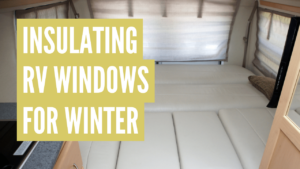
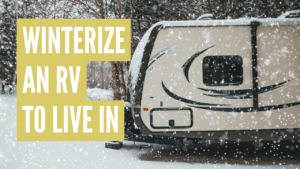
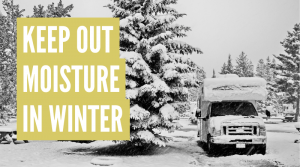
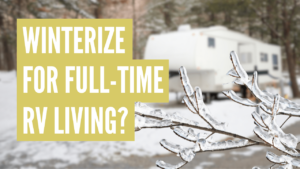
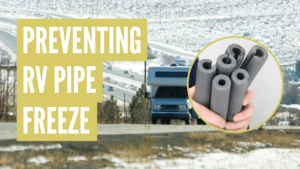
This blog has been amazing and just what I was looking for. It was nice that you added videos as well.